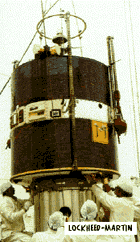SCATHA (Spacecraft Charging At High Altitudes)
SCATHA (Spacecraft Charging At High Altitudes) was a United States Air Force satellite designed to collect data on the electrical charging of spacecraft – an effect caused by repeated passage through the magnetosphere and known to have contributed to several on-orbit satellite failures. Specific goals of the mission were to obtain environmental and engineering data to allow the creation of design criteria, materials, techniques, tests and analytical methods to control charging of spacecraft surfaces, and collect scientific data about plasma wave interactions, substorms, and the energetic ring. The spacecraft was also known as P78-2.
 |
| launch date | Jan 30, 1979 |
| launch vehicle | Delta 2914 |
| launch site | Cape Canaveral |
| orbit | 28,018 × 42,860 km × 10.2° |
| mass | 360 kg |
Spacecraft
Spin stabilized (~1 rpm) with 5° pointing accuracy. Hydrazine propulsion system with 8 thrusters and 2 tanks. Body mounted solar cells generated 290 watts. Three 8Ahr NiCd batteries. Downlink at 8.2 kbps at S-Band from redundant 10 W transmitters. Aluminum, titanium, magnesium, glass fiber structure. Seven deployed experiment booms. 2 tape recorders with ~350 Mb storage each.
Payload
SCATHA carried 12 experiments, which had a total mass of 87 kg and consumed 110 W. The experiments were as follows:
SC1 Engineering Experiments plus VLF and HF Receivers – measured surface potentials of various spacecraft materials, measured RF waves between 0-300 kHz, 2-30 Mhz.
SC2 Spacecraft Sheath Fields Plus Energetic Ions – measured low energy
electrons and ions, energetic protons, and electrons.
SC3 High Energy Particle Spectrometer – measured high energy electrons
and protons.
SC4 Satellite Electron and Positive Ion Beam System – used ion and electron beam guns to control spacecraft surface potential.
SC5 Rapid Scan Particle Detector – measured electrons and ions.
SC6 Thermal Plasma Analyzer (failed soon after initial turn on) – designed to measure thermal electrons and ions.
SC7 Light Ion Mass Spectrometer (failed soon after initial turn on) – designed to measure light ion density, temperature and composition.
SC8 Energetic Ion Compositions Experiment – measured low energy electrons and the ion composition of energetic plasma.
SC9 UCSD Charged Particle Experiment – measured electrons and ions.
SC10 Electric Field Detector – measured DC and ELF electric fields and satellite potential.
SC11 Magnetic Field Monitor – measured DC and ELF magnetic fields.
ML12 Spacecraft Contamination Plus Thermal Control Materials Monitoring – measured contamination rates and property changes of several thermal control material samples.
TPM Transient Pulse Monitor – supported the other experiments by providing supporting data about the electromagnetic pulse environment.


